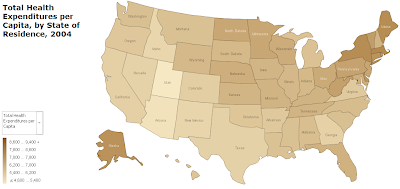
The percentage given is that provided by the ratio of the actual total health expenditure per capita for each U.S. state with respect to the value we would predict given each state's GDP per capita.

For that, we'll turn to our geographic chart depicting each state's total health expenditures per capita.

As we noted yesterday, the likely explanation for this result is that contributions from the U.S. federal government likely "equalize" the level of health expenditures per capita in these states with other states in their region.
That, in turn, would make one of the rare examples of when the U.S. government has successfully, to borrow Thomas Sowell's phrasing, "equalized upward" (HT: Mark Perry). We should note that the practical effect of the current universal health care proposals being drafted by the Obama administration and the current majority party of the U.S. Congress would be to change the emphasis from this approach to instead equalize downward.
Finally, we'll once again confirm that whenever we see levels of spending way out of whack with the levels we would normally expect based on sound economic fundamentals, the government is usually involved.
Labels: data visualization, health care
Welcome to the blogosphere's toolchest! Here, unlike other blogs dedicated to analyzing current events, we create easy-to-use, simple tools to do the math related to them so you can get in on the action too! If you would like to learn more about these tools, or if you would like to contribute ideas to develop for this blog, please e-mail us at:
ironman at politicalcalculations
Thanks in advance!
Closing values for previous trading day.
This site is primarily powered by:
CSS Validation
RSS Site Feed
JavaScript
The tools on this site are built using JavaScript. If you would like to learn more, one of the best free resources on the web is available at W3Schools.com.